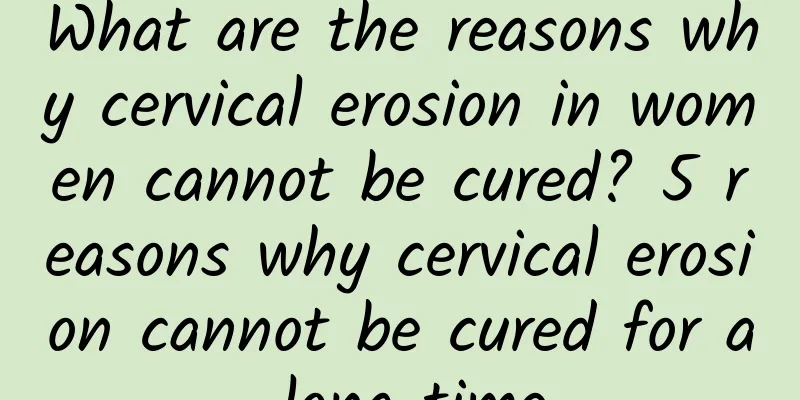What are the reasons why cervical erosion in women cannot be cured? 5 reasons why cervical erosion cannot be cured for a long time

|
In real life, many hospitals have many scientific treatments for cervical erosion, a gynecological disease, and cervical erosion can indeed be relieved after a certain course of treatment. However, many patients still feel that cervical erosion is difficult to cure even after long-term treatment. What is the reason? What are the causes of recurrent cervical erosion? 1. Incomplete treatment of cervical erosion Cervical erosion is a common disease among women. If women interrupt treatment on their own during treatment, or if the treatment is not thorough enough, it is also the reason why cervical erosion cannot be cured. The diseased tissue at the erosion site cannot be completely destroyed during treatment, resulting in residual diseased tissue, which can cause repeated attacks. 2. Suffering from sexually transmitted diseases If the patient has gonorrhea, genital chlamydia infection, genital warts, etc., these pathogens can invade the cervical epithelial cells, causing cervical inflammation, and then leading to cervical erosion. Therefore, if the patient is infected with cervical erosion on the basis of sexually transmitted diseases, it will also cause the disease to recur, making it difficult to cure the cervical erosion. 3. The degree of erosion is relatively large and the degree of lesion is serious The deeper the degree of cervical erosion in women and the larger the area, the more likely the patient's condition will relapse, the lower the chance of complete cure will be, and the recurrence rate will be very high. Generally, mild to moderate cervical erosion has a high cure rate and the condition can be well controlled; however, for women with severe cervical erosion, the cure rate is low and the recurrence rate increases. This shows the importance of early detection and treatment for the complete cure of the disease. 4. Women are older The age of female patients is closely related to the degree of cure of cervical erosion. Generally, the recurrence rate of cervical erosion after treatment is low for women under 30 years old, while the recurrence rate is high for women over 30 years old. 5. Excessive sexual life and unclean sexual behavior After a period of treatment, the symptoms of patients with cervical erosion will improve. However, if they have sexual intercourse too frequently during this period, or if they do not pay attention to personal hygiene during sexual intercourse, bacteria may enter the vagina, induce infection again, aggravate damage to the cervical epithelium, and cause recurrence of cervical erosion after treatment. |
>>: How to treat second degree cervical erosion best? 5 reasons for second degree cervical erosion
Recommend
What are the symptoms that cause irregular menstruation?
Irregular menstruation is a common gynecological ...
Where to treat functional uterine bleeding
Functional uterine bleeding refers to uterine ble...
Why are more and more women having artificial abortions?
Artificial abortion is a last resort remedial mea...
Symptoms of uterine fibroids in women can lead to secondary anemia
Since uterine fibroids often occur in women betwe...
What is the postoperative care for ectopic pregnancy?
Regarding ectopic pregnancy, I believe many women...
How to determine whether it is dysmenorrhea or uterine inflammation How to determine which type of dysmenorrhea
How to determine whether it is dysmenorrhea or ut...
EU juice has no added sugar! Dong's: Choose low-sugar juice carefully
The European Union will stipulate that food manuf...
Brief analysis of the dietary therapy for the treatment of chronic pelvic inflammatory disease
In clinical practice, chronic pelvic inflammatory...
Jian Manshu spent three years losing 6 kg from 49 kg to show off her hot and sexy body! Revealing private exercise and diet secrets, girls please take notes
Jian Manshu showed off her hot body in the Taiwan...
Three causes of vaginitis in unmarried women
Vaginitis is a type of female gynecological disea...
Why is it so important to take good care of your health when your teenage girls have less menstruation?
Girls will start to experience menstruation with ...
Precautions after endometrial thickening surgery
The normal endometrium will change periodically w...
What is abnormal vaginal discharge?
There are many different manifestations of abnorm...
Should women with uterine fibroids get pregnant as soon as possible?
Should women with uterine fibroids get pregnant a...
What kind of exercise should you pay attention to during menopause?
As the saying goes, "Life lies in exercise&q...









